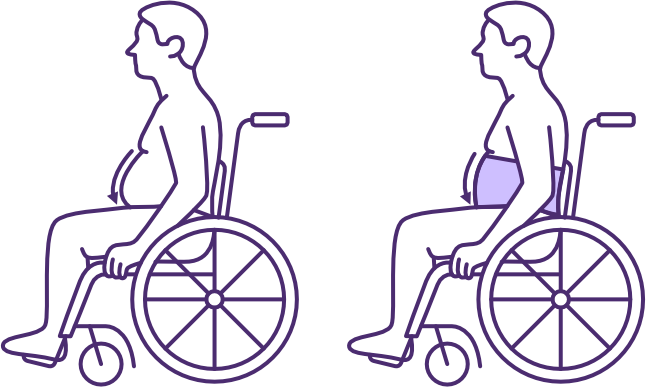Abdominal binder
If abdominal muscle paralysis or significant weakness is present, the use of an abdominal binder is recommended when sitting—and possibly standing.
A well-fitted abdominal binder helps counteract the loss of normal abdominal muscle tone and increased abdominal compliance, when changing position from supine (where gravity is providing assistance). It applies pressure across the abdomen onto the abdominal contents to support:
- venous return in the inferior vena cava, to maintain blood pressure
- dome-shaping of the diaphragm, to improve its position for efficient contraction
- passive and forced expiration.
Overall, the abdominal binder is clinically used in the management of orthostatic hypotension, along with the use of compression stockings and pharmacological interventions.
Due to respiratory changes following SCI, the abdominal binder is also used to enhance lung volumes and reduce the work of breathing in sitting, while improving coughing. One study reported that use of an abdominal binder in sitting for people with a complete SCI above T1, improved maximal inspiratory pressure (MIP), vital capacity (VC), forced expiratory volume in 1 second (FEV1) and peak expiratory flow (PEF). It also increased the time for sustained voice.
Anecdotal evidence suggests that an abdominal binder may also assist with balance and postural cueing during early rehabilitation.
Prescription
An abdominal binder is a wide abdominal wrap, made from elasticised material and secured with velcro. It is worn as an undergarment. Skin integrity must be closely monitored, particularly when there are significant bony prominences covered e.g. ribcage, spinal and pelvic crest. Similarly, an abdominal binder may not always be suitable for use in the context of significant abdominal distension or adiposity.
Prosthetic and orthotic services can assist with measuring and size selection of abdominal binders, as well as any customisation required. This may be necessary to accommodate abdominal tubing, including suprapubic catheters. However, check with the relevant stomal service to clarify if modifications are required for a colostomy.
Ordering two abdominal binders — one for showering and one for use during the day—ensures there is always a dry one available for different uses.
It is important to ensure the correct size and positioning of abdominal binders, to prevent complications such as:
- restricted breathing
- skin breakdown
- stomal/tubing occlusion
- triggering autonomic dysreflexia.
Application
When applying an abdominal binder, it should:
- be fitted while the individual is in supine lying, prior to moving into sitting (this typically requires an assistant)
- be firm but not overly tight
- be positioned below the ribcage and above the bony anterior pelvic landmarks
- not occlude or tension abdominal tubing, including suprapubic catheters
- be worn under clothing, like an undergarment
- be checked in supine, and re-checked once in sitting to ensure proper fit and function.

Effect of an abdominal binder on abdominal compliance in sitting following high-level SCI
Image source QSCIS
Abdominal binders in sitting (v no intervention) on lung volumes in people with SCI who have abdominal muscle weakness or paralysis
SCI Physiotherapy Guidelines
Abdominal binders v no intervention on postural hypotension in people with SCI | SCI Physiotherapy Clinical Practice Guidelines
SCI Physiotherapy Guidelines
Abdominal binders (v no intervention) to improve cough in people with SCI who have abdominal muscle weakness or paralysis | SCI Physiotherapy Clinical Practice Guidelines
SCI Physiotherapy Guidelines
SCIPT Guide. (n.d.). Abdominal binders in sitting vs no intervention on lung volumes in people with SCI who have respiratory muscle weakness. https://sciptguide.com/recommendation/abdominal-binders-in-sitting-v-no-intervention-on-lung-volumes-in-people-with-sci-who-have-respiratory-muscle-weakness
SCIPT Guide. (n.d.). Abdominal binders vs no intervention on postural hypotension in people with SCI. https://sciptguide.com/recommendation/abdominal-binders-v-no-intervention-on-postural-hypotension-in-people-with-sci
SCIPT Guide. (n.d.). Abdominal binders vs no intervention to improve cough in people with SCI who have abdominal muscle paralysis (full or partial). https://sciptguide.com/recommendation/abdominal-binders-v-no-intervention-to-improve-cough-in-people-with-sci-who-have-abdominal-muscle-paralysis-full-or-partial
Sheel AW, Welch JF, Townson AF (2018). Respiratory Management Following Spinal Cord Injury. In: Eng JJ, Teasell RW, Miller WC, Wolfe DL, Townson AF, Hsieh JTC, Connolly SJ, Noonan VK, Loh E, Sproule S, McIntyre A, Querée M, editors. Spinal Cord Injury Rehabilitation Evidence. Version 6.0. Vancouver: p. 1-72.
Wadsworth, Brooke & Haines, Terry & Cornwell, Petrea & Paratz, Jennifer. (2008). Abdominal binder use in people with spinal cord injuries: A systematic review and meta-analysis. Spinal cord. 47. 274-85. 10.1038/sc.2008.126. https://pubmed.ncbi.nlm.nih.gov/22732370/